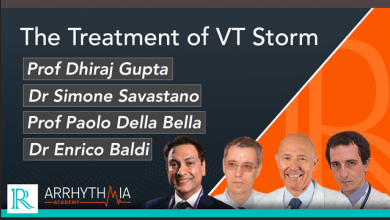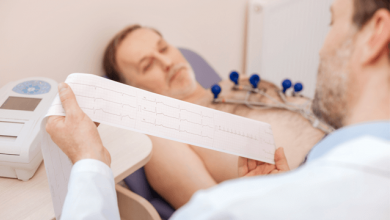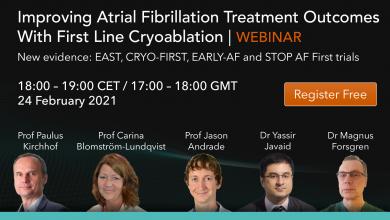Search results
Author(s):
Dhiraj Gupta
,
Paolo Della Bella
,
,
et al
Added:
3 years ago
VT electrical storm is a life-threatening event and an acute clinical emergency.
This edition of Arrhythmia Academy's Journal Club, moderated by Prof Dhiraj Gupta, features an interesting panel discussion with the lead authors of two recently published papers on the topic.
Prof Della Bella provides us with an overview of treatment options for VT storm using a multi-disciplinary approach.
…
View more
Author(s):
Jean-Yves Le Heuzey
Added:
8 years ago
Author(s):
Demosthenes G Katritsis
Added:
3 years ago
Since the identification of the hyperpolarisation-activated cyclic nucleotide channel 4 (HNC4), a major constituent of the pacemaker current (If) in the sinoatrial node, as a modulator of heart rate,1 several genetic causes of sinus bradycardia by means of mutations in ion channel encoding genes have been described. They may result in isolated sick sinus sydrome or other arrhythmia and…
View more
Author(s):
Vincent Umbrain
,
Christian Verborgh
,
Gian-Battista Chierchia
,
et al
Added:
3 years ago
The current option for refractory treatment for atrial fibrillation (AF) includes hybrid AF-surgery.1–2 The hybrid approach was originally a combination of mini-invasive surgical epicardial evaluation and ablation, as well as endocardial electrophysiologist (EP) catheter ablation with the intention of creating a lesion set to cure AF.3 In the search for greater efficacy with less patient…
View more
Author(s):
Boris Rudic
,
Rainer Schimpf
,
Martin Borggrefe
Added:
3 years ago
Short QT syndrome (SQTS) is a rare, inheritable channelopathy of the heart characterised by abnormally short QT intervals on the electrocardiogram (ECG) and an increased propensity to develop atrial and ventricular tachyarrhythmias in the absence of structural heart disease.1,2 SQTS was first described as a new clinical entity by Gussak et al. in 2000.1 Until then shortening of the QT interval…
View more
Author(s):
George Paxinos
Added:
3 years ago
Dear Sir,
I read with great interest the elegant article of Umbrain et al.1 on hybrid AF treatment in issue 6.4 of AER. It delineates in a comprehensive but succinct manner the technical problems and peculiarities of this promising approach. However, in my capacity as a general cardiologist and director of a primary care centre, I am very much concerned about the costs of such procedures. In the…
View more
Author(s):
Carina Blomström-Lundqvist
,
Jason G Andrade
,
Yassir Javaid
,
et al
Start date:
Feb 24, 2021
View more
Author(s):
Mahmoud Abdelnabi
,
Ashraf Ahmed
,
Abdallah Almaghraby
,
et al
Added:
3 years ago
Ivabradine is a pure heart rate-lowering agent best characterised by its negative chronotropic effect on the sinoatrial node.1 Its unique mechanism selectively blocks the pacemaker funny (If) channels, which are responsible for spontaneous depolarisation in the sinoatrial node that regulates heart rate during sinus rhythm (Figure 1).2 Since 1980, it has been well established that controlling the…
View more
Author(s):
Konstantinos C Siontis
,
Hakan Oral
Added:
3 years ago
Advanced catheter-based technologies employed for the ablation of symptomatic atrial fibrillation (AF) have revolutionised the management of this common sustained arrhythmia. In the late 1990s, premature depolarisations originating from the myocardial sleeves within the pulmonary veins were recognised to initiate AF. This landmark discovery rendered pulmonary vein isolation (PVI) as the…
View more
Author(s):
Vincent Umbrain
,
Mark La Meir
,
Carlo de Asmundis
Added:
3 years ago
Dear Sir,
The question referring to the financial costs of one-stage hybrid surgery for atrial fibrillation in countries where reimbursement is limited is relevant in our modern cost–benefit driven society. But your question is out of the context of our manuscript as we never alluded to the financial aspects of the technique.
Costs for one-stage hybrid atrial fibrillation surgery are important…
View more















